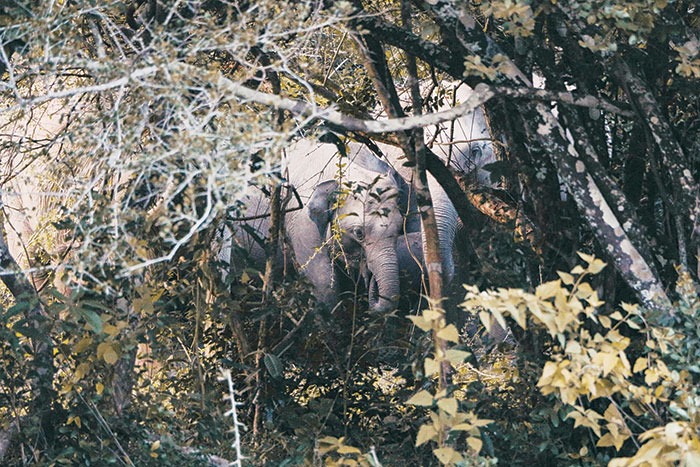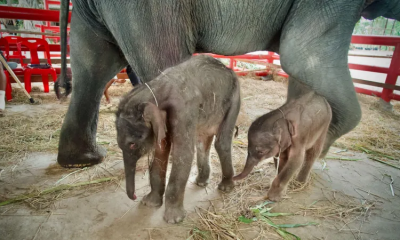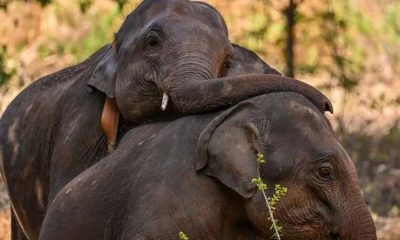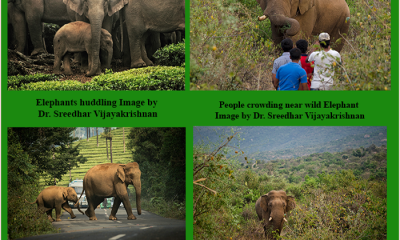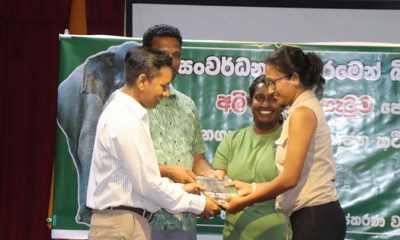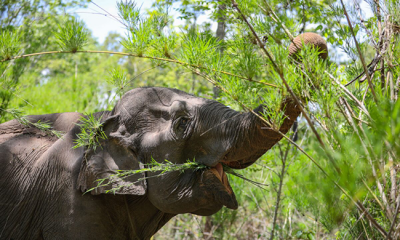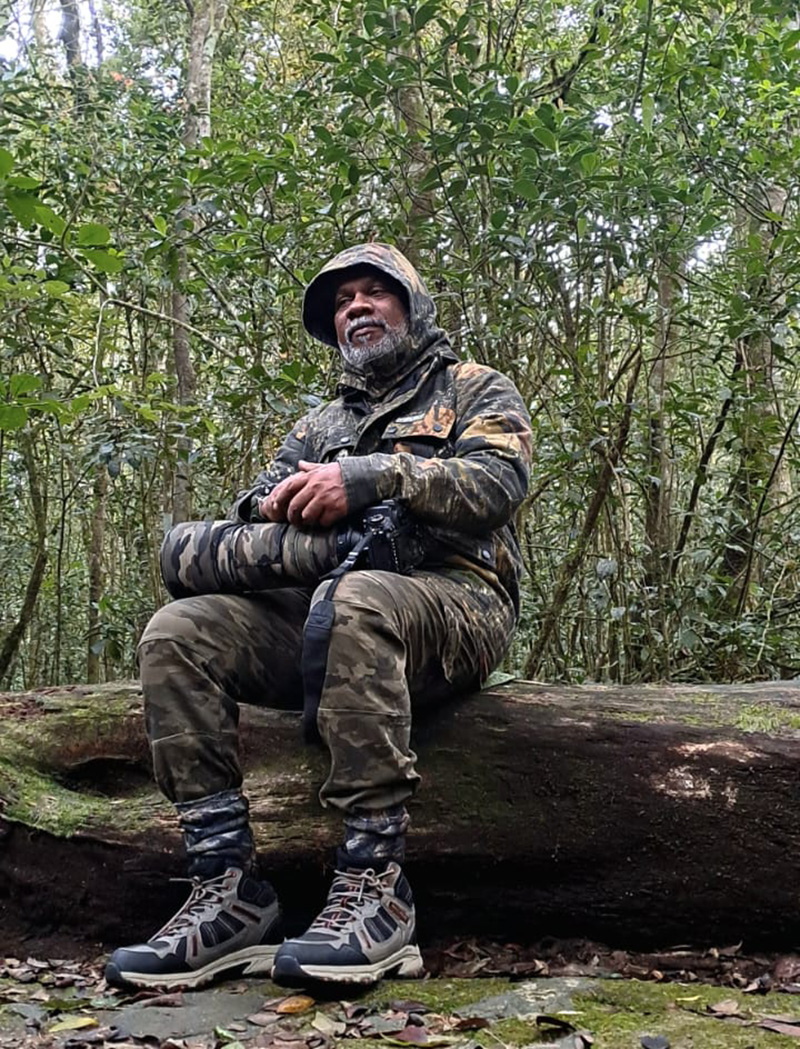Life style
The Secret to Saving Asian
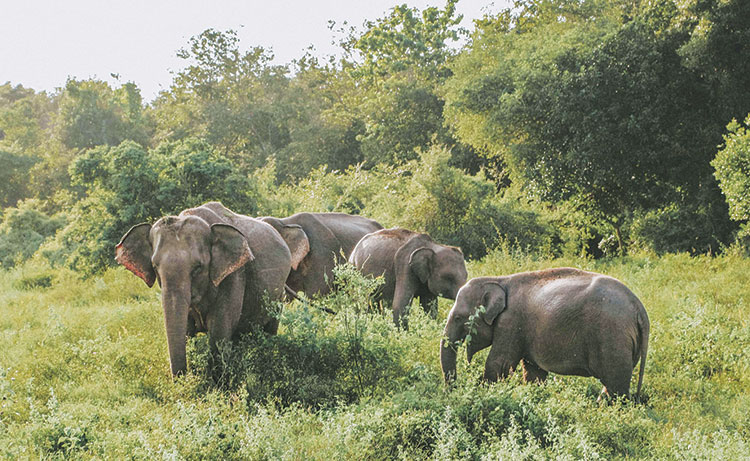
Elephants ? Oranges
BY ZINARA RATNAYAKE
In Sri Lanka, human-elephant conflict has disrupted farmers for generations. In some cases, people are killed. Now, a local conservation organization is looking to citrus as a solution. Bees and fences can’t stop elephants from attacking villages—but orange trees miraculously can.
The November morning was blue-skied and bright. When Wije appeared behind the large orange tree shading his front yard, his eyes crinkled with a broad smile. He wore a rainbow-coloured sarong, a blue face mask, and a Sri Lanka Wildlife Conservation Society (SLWCS) T-shirt. This is where he works as a fieldhouse manager. He plucked an orange from a tree to prepare juice. In his village, oranges aren’t just a fruit. They’re a solution to an age-old environmental problem: human-elephant conflict.
Like many villages in the countryside of Sri Lanka, Pussellayaya boasts postcard-worthy landscapes. Wije, short for Aluthgedara Wijerathne, is a 43-year-old native of Pussellayaya, which sits in the southern boundary of Wasgamuwa National Park, about 143 miles from the capital city Colombo in Sri Lanka.
When the charred evening clouds in November bring rain to the village, farmers start sowing the fields of paddy that disappear into a ridgeline of the Knuckles Mountain Range. In the coming months, farmers toil in the fields, but the surrounding wildlife doesn’t make their life easy.
“During the last decade, elephants killed four villagers,” says Wije in his native language Sinhala. “We get very scared at night. Elephants came to destroy our crops and houses. We didn’t have a choice but to retaliate. We lit firecrackers to scare them off, but they became more aggressive, so we fired gunshots into the air, and sometimes at elephants. We didn’t want to harm wild animals, but they were destroying everything we had.”
Growing up in the village, Wije remembers the sleepless nights he spent with his parents. They lit fires and slept on rickety treehouses in the open air in the rice fields, trying to scare off hungry elephants looking for ripe paddy—the only source of income Wije’s parents had.

Orange trees have helped protect Wije’s rice crops while helping him branch out into the world of citrus.
Wije’s story is not different from that of thousands of others living in rural Sri Lanka. The country’s rapidly growing human population and subsequent demand for land result in clearing of natural habitats, squeezing wild animals—like elephants—into smaller pockets of land
The Sri Lankan sub-species of the Asian elephant is already endangered—with as few as 2,500 elephants remaining in Sri Lanka today—but this forces them into shattered jungle habitats. Wild elephants rampage adjacent villages (their original habitat) looking for natural sources of food and water.
A 2010 report by Columbia University’s Earth Institute found that, historically, elephant deaths coincided with reduced rainfall in Sri Lanka’s eastern region. The climate crisis is set to change precipitation patterns in the country and increase the risk of drought. Sri Lanka, which ranked second in the 2019 global climate risk index, already experiences erratic weather patterns.
During Sri Lanka’s dry season, water bodies dry up. Trees wither. Water buffaloes resort to the last remaining mud puddles while searing hot weather cracks the arid soil. In this fetid heat, elephants frequently wander around looking for water, some of them migrating through human habitats where resources exist.
Every year in Sri Lanka, the elephants destroy $10 million worth of crops and property. For the last two years, elephants have killed more than 90 people a year in Sri Lanka. Fearful farmers fight back; in 2019, they killed a record 405 elephants. While human-elephant conflict is a threat to these jungle giants, it also puts impoverished farmers in a vulnerable situation.
“We need to help humans first. If we do that, we can save elephants.”
In the early 1990s, conservationists in Sri Lanka tried to solve the problem by installing electric fences around the villages. But elephants are smart creatures: They began using sticks or branches to break these wires. Busy farmers then have to spend time rebuilding the wires. Ravi Corea, founder of SLWCS, says that farmers who live hand to mouth don’t have the luxury of spending time on such repairs.
Corea understood the need for a long-term solution during his time near Wasgamuwa about three decades ago. After he launched SLWCS in 1995, Corea initiated the project Saving Elephants by Helping People (SEHP) in 1997 to research community-led responses. “I realized that we need to help humans first,” he says. “If we do that, we can save elephants.”
Around 2005, Corea got a surprising tip from the villagers. “Elephants are amazing creatures,” he says, laughing. “They like to remind us that they are the kings in the jungle.”
Elephants often display their power by uprooting trees—but there was one type they left alone: citrus.
So a year later, SLWCS conducted a series of feeding trials with six captive Asian elephants at Dehiwala Zoo, located in suburban Colombo. While elephants gulped down other things such as melons, bananas, paddy, and palm leaves, they tended to eschew oranges and lime fruits and leaves. Their study (which has not been peer-reviewed) concluded that Asian elephants in Sri Lanka have a natural aversion to citrus.
The researchers never found out why elephants didn’t like citrus—they suspect the compound called limonene might be behind it—but those results were promising enough to expand the solution. Corea had already tried other options in between—like beehive fences. They involve fencing the farmer’s crops with beehives. This invention has worked in parts of Africa, but Sri Lankan bees don’t sting as hard as the killer bees of Africa. Moreover, the bees would leave in the dry season in search of water.
By 2011, SLWCS moved forward on the potential citrus solution: It donated orange trees to 12 farmers in Radunna Wewa, another small hamlet in Wasgamuwa. After three years, as the orange plants grew, the farmers saw the difference the plants made. While elephants still stormed through the surrounding main roads, they would take a detour when they smelled citrus. The strong smell of orange now keeps the elephants out of the village, protecting crops and property.
Sixty-year-old Waththegedara Anulawathie is one of Radunna Wewa’s first orange growers. “Elephants don’t come now,” Anulawathie says, her wrinkled face lighting up. Her black and gray hair is loosely braided; her baby pink blouse bright against the backdrop of paddy fields nearby. “Some months, we lost most of our harvest,” she says, pointing to where elephants reduced a house to nothing. “Now we go to sleep at night,” she smiles.
Since their earliest program in Radunna Wewa almost 10 years ago, SLWCS has planted trees in more than 12 villages in the Wasgamuwa region, distributing 25,000 orange plants. Pussellayaya is one of their latest additions. Each of the village’s 300 houses has at least 10 orange trees. In the last five years, SLWCS has estimated that the Wasgamuwa region contributed only about two percent to national human-elephant conflict—including property and crop damage, human deaths, and elephant deaths—according to annual data the organization collects from the region’s Department of Wildlife Conservation.
“Now elephants don’t harm the poor farmers, and farmers don’t harm the elephants,” Corea says, “It’s a win-win for both parties.”
While oranges kept elephants away, their commercial value further incentivized farmers to cultivate the crop. Most traditional paddy farmers struggle to meet their needs, but oranges now provide them an additional income. Farmers grow Bibile sweets, a green orange from Bibile, Sri Lanka, which suits the climate. Anulawathie says a fully grown tree yields about 300 to 500 oranges, which she sells for 15 rupees (about $0.10) each.
However, soaring heat and extreme drought threaten these orchards. In Anulawathie’s garden, two young trees died in August, the driest month of the year. While SLWCS has already developed an irrigation system that brings in water from nearby canals, lakes, and springs, farmers are still struggling.
As more farmers grow Bibile sweets, Corea says they will help protect the natural water springs. Once the trees grow into large orchards, they’ll help shade the bare soil from the harsh sun. Birds, butterflies, and other insects come for orange flowers, too, increasing the area’s biodiversity. “Oranges are addressing the issues of the ecosystem shared by elephants, humans, and other wildlife,” Corea says.
SLWCS relies on volunteers and donations for its projects. While Corea has plans to expand this program, the conservation efforts would require more financial support and intervention from government authorities. Corea and his team had planned to begin feeding trials in Tanzania to African elephants, but the pandemic put that on pause. “We want to see if African elephants show a resistance to citrus as well.”
Now that elephants don’t come to raid their paddy, farmers in Pussellayaya can sleep peacefully. They can reap and sell their harvest in full. Wije, for instance, was able to buy a tuk tuk (auto rickshaw) with last year’s earnings. Wije walks me around the village and shows me a home. The garden is dotted with orange trees, planted only four years ago. In May, the family sold their first harvest.
We walk to the SLWCS field office, and Wije squeezes a few oranges for juice. It’s a great way to kill the scorching heat. Wije peels off the orange rind, but he has already learned that the outer skin is also useful. SLWCS is planning to make essential oil from orange peel, as well as introduce products with a longer shelf life: jam, bottled-juices, and cordials.
Wije believes these products can help bring more income to the villagers. “Until then, we are thankful that elephants don’t come here anymore. Our rice is safe. Our houses are safe. We are safe,” Wije says, smiling. “Elephants are safe, too.”
(BBC)
Life style
What I Do, What I Love: A Life Shaped by Art, Wilderness and Truth

In a country where creative pursuits are often treated as indulgences rather than vocations, Saman Halloluwa’s journey stands apart — carved patiently through brushstrokes, framed through a camera lens, and articulated through the written word. Painter, wildlife and nature photographer, and independent environmental journalist, Halloluwa inhabits a rare space where art, ecology and social responsibility converge.
His relationship with art began not in galleries or exhibitions, but in a classroom. From his school days, drawing was not simply a subject but an instinct — a language through which he learned to observe, interpret and respond to the world around him. Under the guidance of two dedicated mentors, Ariyaratne Guru Mahathaya and Gunathilaka Guru Mahathaya, he honed both skill and discipline. Those early lessons laid the foundation for a lifelong engagement with visual storytelling.

“His work navigates between traditional Sinhala artistic sensibilities, abstract compositions and expansive landscapes.”
 That commitment eventually materialised in two solo art exhibitions. The first, held in 2012, marked his formal entry into Sri Lanka’s art scene. The second, staged in Colombo in 2024, was a more mature statement — both in content and confidence. Featuring nearly fifty paintings, the exhibition drew an encouraging public response and reaffirmed his place as an artist with a distinct visual voice.
That commitment eventually materialised in two solo art exhibitions. The first, held in 2012, marked his formal entry into Sri Lanka’s art scene. The second, staged in Colombo in 2024, was a more mature statement — both in content and confidence. Featuring nearly fifty paintings, the exhibition drew an encouraging public response and reaffirmed his place as an artist with a distinct visual voice.
His work navigates between traditional Sinhala artistic sensibilities, abstract compositions and expansive landscapes. There is restraint in his use of form and colour, and an underlying dialogue between memory and space. Yet, despite positive reception, Halloluwa speaks candidly about the structural challenges faced by artists in Sri Lanka. Recognition remains limited; fair valuation even rarer.
“This is not merely an artistic issue,” he observes. “It is a social and economic problem.”
In Sri Lanka, art is often viewed through the lens of affordability rather than artistic merit. Many approach a painting by first calculating the contents of their wallet, not the value of the idea or labour behind it. In contrast, he notes, art in Europe and many other regions is treated as cultural capital — an investment in identity, history and thought. Until this mindset shifts, local artists will continue to struggle for sustainability.
The decisive push toward wildlife photography came from Professor Pujitha Wickramasinghe, a close friend who recognised both Halloluwa’s observational skills and his affinity with nature. From there, the journey deepened under the mentorship of senior wildlife photographer Ravindra Siriwardena.
Both mentors, he insists, deserve acknowledgment not merely as teachers but as ethical compasses. In a field increasingly driven by competition and spectacle, such grounding is invaluable.
Wildlife photography, Halloluwa argues, is among the most demanding visual disciplines. It cannot be improvised or rushed. “This is an art that demands restraint,” he says.
Among all subjects, elephants hold a special place in his work. Photographing elephants is not merely about proximity or scale, but about understanding behaviour. Observing social patterns, movement, mood and interaction transforms elephant photography into a constantly evolving challenge. It is precisely this complexity that draws him repeatedly to them.
Halloluwa is cautiously optimistic about the current surge of interest in wildlife photography among Sri Lankan youth. Opportunities have expanded, with local and international competitions, exhibitions and platforms becoming more accessible. However, he issues a clear warning: passion alone is not enough
Sri Lanka, he believes, is uniquely positioned in the global nature photography landscape. Few countries offer such concentrated biodiversity within a compact geographical area. This privilege, however, carries responsibility. Nature photography should not merely aestheticise wildlife, but foster respect, aware ness and conservation.
Parallel to his visual work runs another equally significant pursuit — environmental journalism. For the past seven to eight years, Halloluwa has worked as an independent environmental journalist, giving voice to ecological issues often sidelined in mainstream discourse. His entry into the field was guided by Thusara Gunaratne, whose encouragement he acknowledges with gratitude.
An old boy of D.S. Senanayake College, Colombo, Halloluwa holds a Diploma in Writing and Journalism from the University of Sri Jayewardenepura and has completed journalism studies at the Sri Lanka Press Institute. He is currently pursuing an Advanced Certificate in Wildlife Management and Conservation at the Open University of Sri Lanka — a testament to his belief that learning must remain continuous, especially in a rapidly changing ecological landscape.
Outside his professional life, he enjoys cricket, rugby and badminton. Yet even leisure intersects with responsibility. He is a founding member and former president of the D.S. Senanayake College Old Boys’ Wildlife Forum, an active member of Wild Tuskers Sri Lanka, and a contributor to several independent environmental and wildlife volunteer organisations. In an era dominated by speed, spectacle and short attention spans, Saman Halloluwa’s journey unfolds differently. It is deliberate, reflective and rooted in values. Through art, he captures memory and form. Through photography, he frames life beyond human control. Through journalism, he asks uncomfortable but necessary questions.
“What I do, what I love” is not fashion here.
It is conviction — patiently lived, quietly asserted, and urgently needed in a country still learning how to value its artists, its environment and its truth.
By Ifham Nizam ✍️
Life style
Shaping the future of style

Ramani Fernando Sunsilk Hair and Beauty Academy
Ramani Fernando Sunsilk Hair and Beauty Academy marked their graduation of their latest cohort of aspiring hair professionals in a ceremony held at Kingsbury Hotel.
For over two decades, the Ramani Fernando Sunsilk Hair and Beauty Academy has stood as a beacon of excellence in beauty education in Sri Lanka. Founded by industry icon Ramani Fernando, the Academy has built a reputation for producing highly skilled professionals who go on to make their mark in salons, both locally and internationally. As the newly minted graduates step out into the world, they carry forward not just certificates, but also the promise of creative authority and personal empowerment.
The chief guest for the occasion was Rosy Senanayake, a long-standing supporter of the Academy’s mission. Addressing the graduates her message echoed her enduring belief that the beauty industry is not merely about aesthetic but about. confidence, self-worth and future leaders.
Over months of rigorous training, these young professionals honed their skills in cutting colouring, styling and contemporary artistry readying themselves to set trends rather than follow them.
Each graduate walked the stage with confidence, their dedication signalling a promising future for Sri Lanka’s beauty and fashion industry! With this new generation of stylists preparing to raise the standard of professional hairstyling.
Ramani Fernando, addressing the audience reflected on the academy’s mission to cultivate not only skills but vision and confidence in every student.
She urged the graduates to embrace continuous learning to take risks with creativity .The world of beauty is ever evolving, stay curious, stay bold and never underestimate the power of your talent, she added emphasising the importance of confidence, discipline and passion in carving a successful career in shaping the future of style.
These graduates are stepping into a world of endless possibilities. They are future of the country, who will carry a forward legacy of creativity. Behind every successful graduate at Sun silk Hair Academy stands a team dedicated to excellence. While Ramani Fernando serves as a visionary Principal and it is Lucky Lenagala, her trusted person who ensures that the academy runs seemingly.
From overseeing training sessions to guiding students, through hands on practice, Lucky plays a pivotal role in shaping the next generation of hairstylists.
Kumara de Silva, who has been the official compere Ramani’s, Hair graduation ceremony, from inception has brought energy, poise and professionalism. The Sunsilk Hair Academy is a celebration of talent and mentor ship for the graduates stepping confidentially into the next chapter of their careers, ready to make their mark on Sri Lanka beauty landscape
Pix by Thushara Attapathu
By Zanita Careem ✍️
Life style
Capturing the spirit of Christmas

During this season, Romesh Atapattu’s Capello Salon buzzes with a unique energy – a blend of festive excitement and elegance. Clients arrive with visions of holiday parties, office soirees, seeking looks that capture both glamour and individuality. The salon itself mirrors this celebrity mood. Warm lights, tasteful festive décor create an atmosphere where beauty and confidence flourish.
Romesh Atapattu himself curates the festive décor, infusing the space with his signature sense of style. His personal eye ensures that the décor complements the salon’s modern interiors.
As Colombo slips effortlessly into its most glamorous time of year, the Christmas season brings with it more than twinkling lights and celebrity soirees – it signals a transformation season at salons across the city. Capello salons are no exception.
At the heart of this festive beauty movement is Romesh Atapattu of Capello salons, a name synonymous with refined hair artistry, modern elegance and personalised style.
Christmas is about confidence and celebration. Romesh believes ‘People want to look their best without losing who they are”. Our role is to enhance, not overpower. This philosophy is evident in the salon’s seasonal approach.
Beyond trends, what sets Atapattu apart is the attention to individuality. Each consultation is treated as a creative collaboration – face shape, lifestyle, hair texture and personal style all play a role in creating the best for Romesh.
Stepping into Romesh’s salon during the Christmas season is an experience in itself. The space hums with festive energy while maintaining an atmosphere of calm sophistication.
The décor embraces the Christmas spirit with understated elegance. Tastefully adorned décor, beautiful Xmas tree, soft gold and ivory tones, and gentle hints of red are woven seamlessly into the salon’s contemporary design.
His staff, known for their warmth and professionalism also plays a key role in shaping the salon’s atmosphere—friendly, stylish and always welcoming. The Capello staff combine skill and creativity to deliver results that have a lasting impression.
Beyond trends, what sets Romesh Atapattu apart is the attention to individuality. Each consultation is treated as a creative collaboration – face shape, lifestyle, hair texture and personal style all play a role.
He is a professional who blends technical mastery with a deeply personal approach to style. His dedicated team of skilled professionals, operate with quiet confidence ensuring styles that create an atmosphere of trust, turning every appointment into a personalised and memorable experience.
(ZC) ✍️
Pic by Rohan Herath
-

 News7 days ago
News7 days agoMembers of Lankan Community in Washington D.C. donates to ‘Rebuilding Sri Lanka’ Flood Relief Fund
-

 News5 days ago
News5 days agoBritish MP calls on Foreign Secretary to expand sanction package against ‘Sri Lankan war criminals’
-

 Features7 days ago
Features7 days agoGeneral education reforms: What about language and ethnicity?
-

 News7 days ago
News7 days agoSuspension of Indian drug part of cover-up by NMRA: Academy of Health Professionals
-

 Sports5 days ago
Sports5 days agoChief selector’s remarks disappointing says Mickey Arthur
-
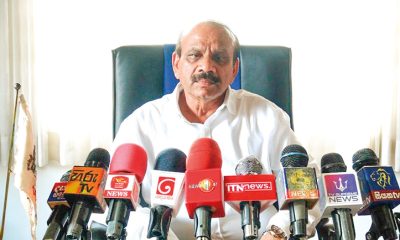
 News4 days ago
News4 days agoStreet vendors banned from Kandy City
-

 Editorial7 days ago
Editorial7 days agoA very sad day for the rule of law
-

 News7 days ago
News7 days agoUS Ambassador to Sri Lanka among 29 career diplomats recalled


